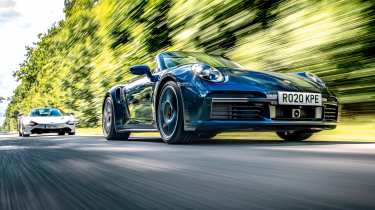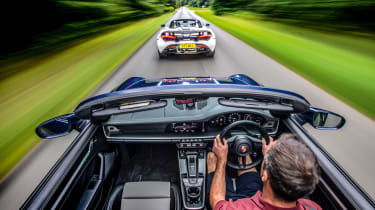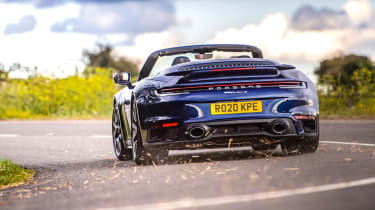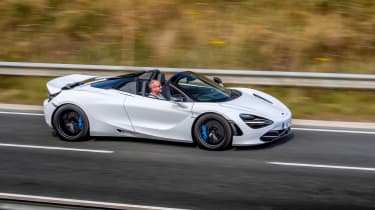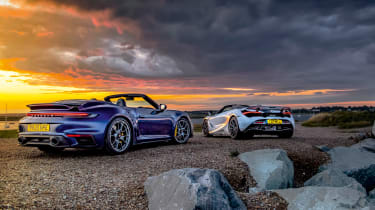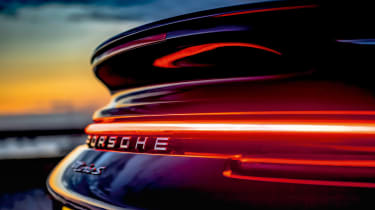Porsche 911 Turbo S Cabriolet v McLaren 720S Spider
Convertibles add weight and reduce stiffness, though they can be undeniably seductive. But do they make any sense with supercar levels of performance? The McLaren 720S Spider and 911 Turbo S Cabrio should provide the answer
It’s time for a confession. One of the most enjoyable drives I’ve ever had in a Porsche 911 was at the wheel of a convertible variant. There, I’ve said it.
It was a 997.1 Carrera S Cabriolet and I drove it to and from that year’s Le Mans 24 Hour race. (I’m so sorry.) The weather was scorchio for the whole few days, the racing thrilling and the atmosphere brilliant. My tent fitted in the front ‘boot’ and the rest of my stuff was jammed into the rear seats (the good old 911 made everything so easy). I took the scenic route for part of the drive down, and tooling gently around the French countryside to visit different parts of the circuit during the race was just heavenly, particularly at night when the warm evening air lapped lazily around the cockpit to the soft ‘tap, tap, tap’ of suicidal French insects meeting their maker on the windscreen. I just loved it. Can I ever be forgiven?
> Dream drive: McLaren P1 in the Pyrenees
Because that’s the thing about convertibles, isn’t it? Particularly those based on a monocoque structure. They’re a compromise. Heavier, less rigid, a poorer platform for a car’s suspension to work from – liking them is effectively tantamount to admitting that driving isn’t at the top of your list of priorities. For those of us who have bought into everything this magazine stands for, that’s an uncomfortable truth we don’t necessarily want to ally ourselves with. And what does lie at the top of that list if not driving? Being seen more readily by others for the benefit of one’s ego? Most of the factors that attract people to convertibles aren’t things that we’d generally want to admit to.
You know how it goes: there you are, trawling the classifieds, looking at old BMW M3s (again). E46s to give you that uneasy feeling that you’ve missed the boat already; E36s to confirm that the ship has already called into port on a different continent. And the first thing you do is filter out the ‘cabs’, because, well, that’s not really an M3, is it? It’s a cabriolet, not a car for people like you and me...
And yet convertibles clearly do have great appeal, even in a climate well known for its grey, rainy days. To help us nail that appeal, we have here two stellar examples of the breed, the McLaren 720S Spider and the Porsche 992 Turbo S Cabriolet. Open sports cars don’t get much more powerful, ostentatious or opulent than this pair – or more divergent within their overall niche.
Yes, we could compare them, and I feel duty bound to indulge in that at some point in this piece, but in reality it’s a fairly fruitless pursuit. You may even be able to write the conclusion for me now, but just in case you can’t, here’s a brief summary of how I reckon it’s going to go: the McLaren has all the drama of a supercar, its tub structure offering open-air vivacity for little compromise, but the Porsche is more dependable, more useable, and almost equally as fast for less money. We shall see…
It’s certainly true that some cars make the transition better than others. You wouldn’t necessarily want a 911 GT3 convertible for laps of the Ring and Spa (even if those who have driven a 991 Speedster tell me it’s actually very good), but there are particular cars where the conversion to a roofless experience actually sits very naturally with their overall demeanour. One example is the Lamborghini Huracán Evo Spyder that we drove back in evo 267. At first glance this seemed like everything that was wrong about the modern supercar, neatly wrapped into a package covered in £12,000 worth of optional orange paint. It weighed 120kg more than the coupe version, which took it to 1542kg ‘dry’, a classic Italian supercar manufacturer’s tactic for hiding the true comparable weight of their cars. What’s the betting that with a few options one of those ‘junior’ Lambos doesn’t tip the scales at 1.7 tons…
In fact, I ended up driving that Huracán around in the rain with the top lowered and loving every second. Sure, I’m certain I looked like a complete berk, but the workings of that incredible V10 felt so close it was as if each piston stroke was a heartbeat. Meanwhile a summer thunderstorm enhanced the distinctive aroma of freshly mown lawns and wild country meadows, and the rush of the slipstream made the Spyder feel 50 per cent faster than I was actually travelling – and therefore 50 per cent less illegal than the speeds at which I might otherwise have been tempted to drive – but also usefully whipped the rain droplets over my head and behind. It was the full, 360-degree cinematic experience, immersive in the extreme, and it completely removed me from everything else that had gone on that day. This was pure escapism, in spite of the Spyder feeling a bit portly, ever so slightly wobbly at times, and probably rubbish for a trackday.
And, more than anything, that’s what convertibles give us: a chance to be closer to the environment that we’re passing through, whatever or wherever that may be. When you’re driving in a car open to the elements it’s amazing what you hear that would otherwise be smothered. The snap of a twig under a tyre; the shout of voices in the park; the distinct chirpings of individual birds.
To be truthful, that sort of detail does rather get lost in the all-enveloping roar when you’re travelling in the 720S, so accelerative is this 710bhp projectile. Be brave or foolish enough – and persistent enough – to disengage the ESP and, as you feel the full, nanny-free force of the twin-turbo V8 it’s an urgent reminder that cars like this are too fast for the road, however feeble it may sound to say it. The V8 needs a few revs and a moment to really spin up to full potency, but its top end is completely brutal, mixing fear and excitement into a potent cocktail that often flirts with the line that separates enjoyment and unsocial unease. The twin-clutch ’box can fire home ratios as fast as any out there, and the unassisted steering remains a thrillingly chatty partner on the move. The Spider-specific MonoCage II-S tub does without the usual overhead spar, the roll-over protection instead provided by a pair of distinctive carbon structures that project from each rear corner, all of which should mean there’s no compromise to the Spider’s dynamics other than that caused by the 49kg of additional weight due to the roof mechanism. The ‘dry’ weight figure is quoted as 1332kg, the DIN as 1468kg, which frankly makes a mockery of the aforementioned Lambo.
I’m not sure the conversion is completely without drawbacks though. When we first drove the Spider in Arizona (evo 285) it seemed to lack the integrity of the coupe in spite of McLaren’s claims, and, while subsequent cars have felt much more ‘together’ than those early builds, it just doesn’t quite – and we’re talking by tiny amounts here – have the pure, uncorrupted responses of the coupe. Or maybe it’s all just in my head because I know their structures are actually different. Whatever the truth of that, the McLaren still mixes sublimely sophisticated ride control with the ability, as we so often say, to feel like a grown-up Lotus Elise, and I never tire of the brilliant driving position with its commanding visibility and perfectly placed control points.
Yep, if you’re after a drop-top that offers a 100 per cent authentic supercar experience, along with the kind of raw performance that feels like it wants to rip your face off, then it’s hard to beat the 720S. The styling divides opinion, but I happen to think it looks more individual, futuristic and handsome with each passing day, and there’s no denying that it’s a wildly exciting car. It is, though, still very much one about speed – exaggerated in the open version. It might steer better than the Huracán Spyder, but most of the time that twin-turbo V8 sounds nothing better than purposeful. That’s the thing about open cars: they amplify different sensations and encourage alternative desires. I’d readily give away 300bhp for a tuneful engine and a manual gearbox in a convertible.
It’s a gruff-sounding turbo motor and a twin-clutch gearbox for the 911 Turbo S Cab too. And let’s face it, no one needs a Turbo S if they want a 911 Cabriolet – in the context of what you want from a convertible, a standard Carrera offers all the turbo-fed performance that you could ever need, and ticks every other box, too. So this car is a ludicrous indulgence, and yet it knows it and sits quite comfortably in its own skin. It’s utterly undemanding most of the time, and whereas that’s an issue for us in the coupe 911s, where we’re looking for that inspiring driving machine, here I find I’m a lot less bothered, instead smirking away at the ability to marshal into action a small thermo-nuclear device carried out back more or less whenever I feel like it.
There’s no getting away from the fact that the Turbo S is a real, err, porker. Its 1710kg DIN figure seems particularly absurd given that it’s a 911, but then in the metal it does look an absolute monster of a car, from the 21-inch rear rims to the deep body sides and the sheer girth from one rear haunch to the other. Once inside – and after you’ve learnt your way around the myriad switches and the giant screen – it’s a lot less intimidating, and you soon realise that the cornerstone to the car’s character – as has always been the case with 911s – is its sheer useability. It may well be a £170,000 supercar but you just jump in and drive, not really giving any more thought to it than that.
Indeed, in its default mode it feels almost sleepy, with only a hum from the engine as it quickly shuffles up the ratios. So much so that it’s easy to forget there’s 641bhp and, more to the point, 590lb ft of torque under your right foot. Twiddle the mode wheel and the Turbo S springs to attention, suddenly delivering great gusts of propulsion that suck in the horizon at a terrific rate. Its power-to-weight ratio is obviously inferior to the McLaren’s, and it lacks the top-end fury possessed by the British car, but there’s something about the way the Porsche’s flat-six delivers its low-down torque that makes it equally amusing, sometimes even more so. You can imagine it pulling comedy wheelies down the road like a cartoon car, the front tyres pawing away in the air.
Thankfully they remain in contact with the ground, because when the corners do arrive they come at you very quickly indeed. At which point you become extremely grateful for the standard-fit carbon-ceramic brakes because there’s suddenly the sense of a lot of mass travelling very quickly; that the brakes are up to the task of hauling it down from high speed is testament to their brilliance, but unlike other 992 models there’s a sense here that the damping needs to be ratcheted up into Sport to keep the weight in check. Do so and you can hustle the Turbo down a good B-road, working to make it flow rather than its progress being a series of giant torque spikes and massive bouts of retardation.
Is it fun? Sort of. It’s a novelty. The warm evening air is kept largely in check around the cabin, and the exaggerated whooshes, hisses and gasps of the heavily blown ‘six’ are the aural accompaniments – not exactly an operatic soundtrack, but not one without its own appeal either. No, it’s not as rigid as the coupe, despite the work Porsche did during the 992’s engineering phase to ensure the open version wasn’t a floppy embarrassment. The art of reinforcing a monocoque structure sliced open has progressed immeasurably over the past couple of decades, and cars like the 992 Cabriolet no longer feel like a very poor relation, but yes, if you’re looking for the best 992 to drive, this certainly isn’t it.
Instead, it’s about playing to its strengths – taking your kids out in the back for a thrilling blast of slipstream air, or squeezing in some mates for a run to the pub. It’s about using a 641bhp 911 as a daily driver (prior experience and internet hearsay suggests you’d have to be a much more patient soul to attempt this in the 720S, which doesn’t inspire the same sort of confidence) and feeling like an extra from Miami Vice. It may not be my ‘thing’, but the more time I spent with the car, the more I could see the appeal of it. And that’s the point with the majority of convertibles: logic suggests they’re inferior machines, but when has logic ever held an important seat at the table of car enthusiasm?
Specs
| Porsche 911 Turbo S Cabriolet | McLaren 720S Spider | |
| Engine | Flat-six, 3745cc, twin-turbo | V8, 3994cc, twin-turbo |
| Power | 641bhp @ 6750rpm | 710bhp @ 7250rpm |
| Torque | 590lb ft @ 2500-4000rpm | 568lb ft @ 5500rpm |
| Weight | 1710kg | 1468kg |
| Power-to-weight | 381bhp/ton | 491bhp/ton |
| 0-62mph | 2.8sec | 2.9sec |
| Top speed | 205mph | 212mph |
| Basic price | £170,410 | £242,000 |
This story was first featured in evo issue 288. To purchase any back issues, or subscribe visit our online shop here

